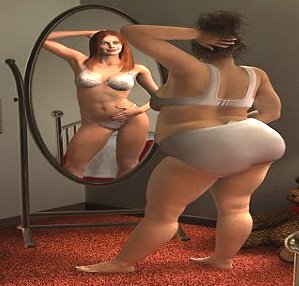
Self Images
The image we have of our self in our dreams, shows the struggle we have with who we think we are. It is the way we try to gain identity. In this struggle, this adventure – very like the Odyssey – we meet all manner of creatures, people, demons, temptations. We travel into dark places, climbs to the heights of wondrous experience, discover magical powers. One of the functions of dreams can therefore be thought to be that of aiding the survival of our identity in facing the multitude of influences in life – and even in death.
We can try to build an image of ourselves through our looks, our financial situation, our sexual prowess or our physical sexual attributes by showing them – the low-cut dress. We may have a self-image built upon our success – as famous singers do.
If the person has positively identified with the society in which they live, and if their self-expression meets with success or reward, then they may experience satisfaction in the first half of their life. If otherwise, they may suffer some degree of depression, anxiety or emotional ill health. In either case the person has been largely shaped by factors other than their own power to shape their life. But in fact, we are made up of many different things which we fail to acknowledge. We are trapped in what has formed us. But the individual can break through the ready-made boundaries of their personality. See Programmed
One of the great and often self-defeating self-images is that with our body. If we accept that dreams portray in images our conception of self, then dreams suggest that our identity largely depends upon having a body, its gender, health, quality, skin colour, the social position we are born into, and our relationship with others. In fact, we know that if a person loses their legs, becomes paralysed, loses childbearing ability, becomes blind or is made redundant, they face an identity crisis. Yet despite all of that they still exist as a person, and if we realise that early we can avoid all the pain and distress caused by a complete identification with our body.
Another side effect is exactly the same as the above; the person believes that the body is them. So, any injury or illness suffered feels like a threat to their own self-image. I witnessed this so many times while working as a nurse. Because of the effects of thinking in that way it hinders healing and recovery of self-confidence.
Or maybe you identify with the way you look, your face, your hair or the shape of your body. But this changes with age, sometimes radically, and old people often say, “Although I look in the mirror and the person I see appears incredibly different to how I looked years ago, inside I still feel as if I am about 20 or 30 years old.”
In fact, we know that if a person loses their legs, becomes paralysed, loses childbearing ability, becomes blind or is made redundant, they face a crisis with their image of their self. Yet despite all of that they still exist as a person, and if we realise that early we can avoid all the pain and distress caused by a complete identification with our body. But the realisations that those things are all external, and is based on the belief that their body is them is the cause if such suffering. But experience of self shows the human possibility of sensing self as having separate existence from the biological processes, from one’s body, one’s state of health, and social standing. See Near death experience
In its most naked form, the ‘I’ may be simply a sense of its own existence, without body awareness. It is the I AM alone and not the I am worried, I am feeling cold, I am in love, I am alone – they are all things that the I AM can experience, and are all passing impressions, not the stable existence. I see that the dream image is like a holographic presentation of what the dreamer feels, thinks, desires or fears about the person whose image it is.
You can begin to get a sense of this by simply saying, I AM. This avoids you getting lost in all the peripheral sense impressions which are all passing experience. So, avoiding such thoughts as I am depressed – I am lonely – I am a talented person – I am so sexy – I am good to look at – and so on.
